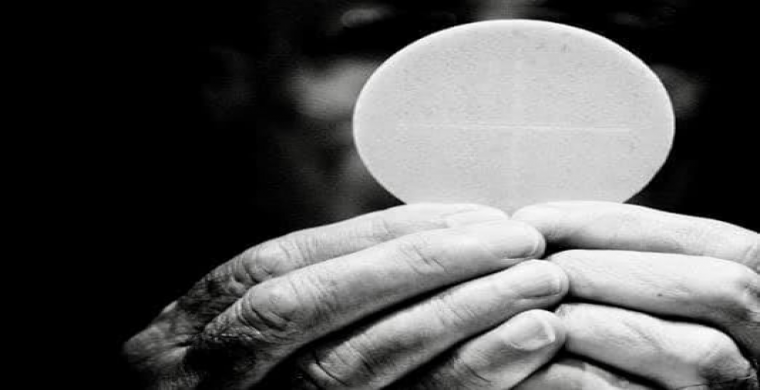TRANSUBSTANTIATION VS CRANMER & REAL PRESENCE
By Chuck Collins
https://www.anglicanism.info/blog
December 1, 2021
Transubstantiation is "repugnant to the plain words of Scripture, overthroweth the nature of a Sacrament, and hath given occasion to many superstitions" (Articles of Religion, 28).
Roman Catholics teach that the substance of the bread and wine become the actual body and blood of Christ, even though, to the onlooker, it still looks like bread and wine (Catholic Catechism, 1379). The Fourth Lateran Council ended on November 30, 1215. This was the first time the word "transubstantiation" was officially used to describe what Roman Catholics understand happens in the sacrament of Holy Communion.
So why did the 16th century reformers adamantly disagree with this view, many even to the point of being willing to die for their beliefs? Why do Anglicans specifically oppose transubstantiation in our confessional statement? Because how we view the "real presence" of Christ in the eucharist hinges every other biblical core value that was recovered at the time of the English Reformation: the supreme authority of Holy Scripture, the priesthood of all believers, and the central biblical doctrine of justification by grace through faith alone.
Anglicans believe that grace is given in the sacrament of Holy Communion ("effectual signs of grace"), and that the real presence of Christ is spiritually experienced in the believer's heart when they receive the grace by faith with thanksgiving. Jesus is spiritually present everywhere ("I am with you always"), but, after his Ascension, he is bodily in heaven where he sits at the right hand of God the Father until the day he will return ("I will return in the same way"). At the Last Supper when Jesus said "This is my body," he was not at that moment giving up his bodily existence to be relocated in the elements of Holy Communion. Jesus is not objectively or corporeally present "in" the bread and wine as if he rushes down from heaven to enter into our mouths and then into our stomachs. It is not "Jesus" sitting on the altar because of some words said or some actions performed over bread and wine by a sacrificing priest. No! It's far more glorious than that! The sacrament of the Lord's Supper unites us again to Christ - "...be filled with thy grace and heavenly benediction, and made one body with him, that he may dwell in us, and we in him." This is the union with Christ or spiritual "commingling" of which Cyril of Alexandria (375-444) writes. His real presence is in the hearts of those who expect and welcome him by faith, and this unites us to the whole Christ (body and spirit), raising us to be again in the Heavenly Places.
Archbishop Thomas Cranmer, the architect of Anglican sacramental theology, wrote extensively about this in "A Defense of the True and Catholike Doctrine of the Sacrament of the Body and Blood of our Saviour Christ" (1550). He devoted the third of four books to the question of real presence citing the church fathers at length. Cranmer wrote: "They [Roman Catholics] say, that Christ is received in the mouth and entereth in with the bread and wine: we say, that he is received in the heart, and entereth in by faith" (Book III, Ch. II). "Cranmer's focus was not a change in, or even instrumental use of, the bread and wine," wrote Ashley Null, "but rather the transformation of the recipients, who by the power of the Spirit were linked afresh to the saving efficacy of Christ's Incarnation and Passion" ("Cranmer and the Sacraments").
Richard Hooker, an Elizabethan theologian, was more nuanced than Cranmer, but his eucharistic doctrine was essentially the same as Cranmer's. He taught that Christ is dynamically present in the liturgical action rather than statically located in the consecrated bread and wine in a moment of consecration (marked by bells, elevating the sacrament, genuflecting, and the like). "The real presence of Christ's most blessed body and blood is not therefore to be sought for in the sacrament, but in the worthy receiver of the sacrament...only in the very heart and soul of him which receiveth" (Laws, V.67.6).
Obviously, many have rushed to other understandings of "real presence" than those found in Anglican formularies. Some even hold to a functionally Roman Catholic understanding without considering how this adversely affects our view of other foundational, biblical teachings. Starting in the 16th century, and arguably all he way back to the teaching of the Apostles and church fathers, the Church of England has maintained a careful balance between word and sacrament in our corporate worship, and we have a view of real presence in Holy Communion that is based on God's promise for union with Christ for believers, "that He may dwell in us and we in Him."
In sum, Jesus is not resacrificed on a sacrificial altar by a priest who possesses an indelible priestly character and serves as the intermediary between God and his people. And the people do not gaze on bread that has turned into Jesus. No, that is Roman Catholic understanding; it's transubstantiation even if it's not called that. Anglicans understand that Jesus's once and for all sacrifice on the cross is the only and completely sufficient sacrifice for the sins of the world, and the sacrament of the Communion table offers Christ, spiritually present, to those who receive the grace of the sacrament by faith. By faith we are reunited to Christ, and even to the whole Christ, body and spirit, and raise to be with him again in the Heavenly Places.
You can read more of Chuck Collins' writings here: https://www.anglicanism.info/blog














